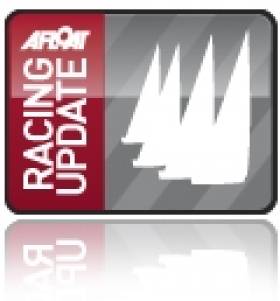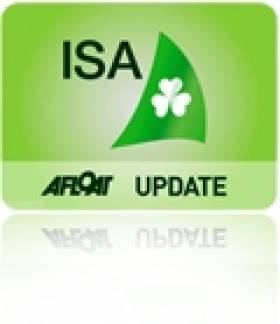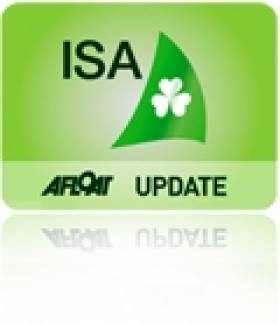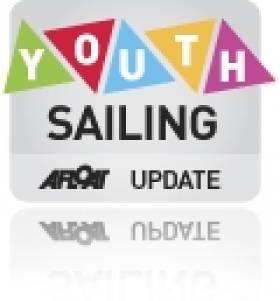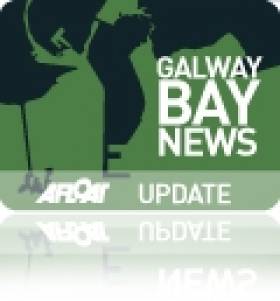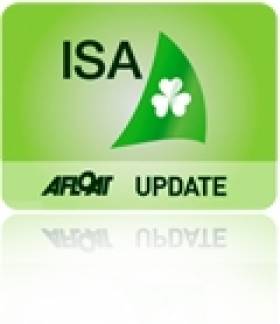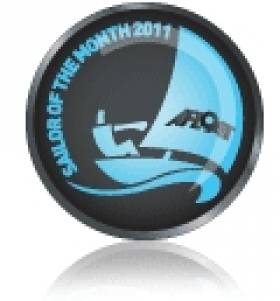Displaying items by tag: ISA
ISAF Posts Review of Development Symposium
#DEVELOPMENT - The International Sailing Federation's (ISAF) inaugural Development Symposium at Howth Yacht Club recently "promised much in the way of passionate discussion", according to its review of the two-day event.
Presentations were given by Tony Wright, training manager of the Irish Sailing Association, who outlined the ISA's national programme that keeps the focus of the sailor "at the centre of all that they do"; and Simon Jinks who walked through his new Guide to Offshore Personal Safety for Cruising and Racing.
Meanwhile, World Youth Sailing Trust coach Hugh Styles spoke on the subject of cohesive training programmes adding value to international events and leaving a legacy for host nations and teams alike.
Participants from the federation's member nations kept an 'ideas bank' which listed development ideas for future consideration, including a proposal for a development forum for sailing coaches, and using the model of the European Qualifications Framework as a reference for coaching competencies.
New Zealand, South Africa, Iceland and Turkey were also suggested as locations for future symposiums.
For more see the full review of the Development Symposium at the ISAF website HERE.
Conference to Highlight Big Sailing Season
#SAILING – An Irish sailing conference has undergone a revamp to boost the sport in Ireland ahead of a season billed as one of the biggest in years.
Irish footwear manufacturer Dubarry of Ireland are on board as sponsors for the one day event on March 3 that includes a number of presentations including one from tourism body Failte Ireland on a long overdue marine leisure strategy for Ireland.
As well as seminars and workshops the Olympic team manager James O'Callaghan will give an Olympic update as three boats (and possibly two more) prepare for the Weymouth regatta in July.
The conference will also deal with the findings of a review of the annual All Ireland sailing championships.
The ISA conference takes place on March 3 in the Royal Marine Hotel, Dun Laoghaire, Co. Dublin.
More from ISA here:
The Irish Sailing Association (ISA) is delighted to announce its partnership with Dubarry of Ireland for the ISA Dubarry 6th Annual National Conference. The event will take place on the 3rd of March in the Royal Marine Hotel, Dun Laoghaire, Co. Dublin to launch what will be one of the most exciting years for watersports in Ireland with so many major international events being hosted in Ireland as well as the participation of the Irish Olympic Sailing team in London 2012.
Dubarry of Ireland Marketing Director, Michael Walsh remarked "2012 is the celebration of Dubarry's 75th year in business, having been established in 1937 in County Galway. Dubarry have had a very long association with sailing in Ireland down the years and we are delighted to sponsor this ISA National Conference in a year that is very special for us. We also have the Volvo Ocean Race coming to Galway with a strong on board Dubarry product presence on both Telefonica and Abu Dhabi Ocean Racing".
The ISA Conference has undergone a revamp for 2012. With many high profile events coming to Irish shores this year it is important for the ISA to provide a platform from which to increase awareness of sailing which in turn will drive incremental participation in the sport.
The one day conference, which will be facilitated by RTE broadcaster Fergal Keane, will host seminars and workshops across a range of interesting topics including the latest training and racing topics, raising money, running successful events and media management delivered by guest speakers.
Among the many seminars, Failte Ireland will be presenting their Marine Leisure Marketing Strategy for 2012 as well as detailing how international events benefit Ireland's tourism industry. Learn more about the international events Ireland will be hosting including the ISAF Youth Worlds, Cork Week, Round Ireland, the Volvo Ocean Race and many more.
With three ISA Olympic Teams having already qualified for London 2012, the ISA High Performance Manager James O'Callaghan will be delivering an Olympic Update as we follow the athletes as they prepare for the pinnacle of four years of training.
ISA Chief Executive Harry Hermon states "We are delighted to welcome Dubarry on board as title sponsors of the ISA Annual Conference and wish them continued success during their 75th year in business. The ISA Dubarry 6th Annual National Conference is free for all ISA members and we are looking forward to a strong attendance at this year's event so we can pull all resources together to drive the sport forward".
'The Rules of Racing' Lecture in Castlebar This Thursday
#RACING - Mayo Sailing Club's winter series of lectures continues this Thursday 23 February with a talk by Ed Alcock on 'The Rules of Racing'.
Alcock is racing manager of the Irish Sailing Association (ISA), and his lecture will outline the laws that govern racing by windpower on the water in Ireland, covering classes from yachts and dinghies to windsurfing, kitesurfing and more.
Topics to be covered include rights and obligations on the water, giving way, keeping clear, red flags and protest forms.
Sailors of all craft are invited to attend the evening, and anyone wanting to get involved in racing is also welcome, especially with the 2012 racing season only eight weeks away.
Alcock's talk takes place this Thursday at 7.30pm in GMIT Castlebar. The Galway Advertiser has more HERE.
EGM to Decide Revised ISA Funding Structure Tomorrow
#IRISH SAILING ASSOCIATION – A good turnout of Sailing Clubs from around the country is expected tomorrow morning in Dun Laoghaire to vote on revised club affiliation fees for funding the Irish Sailing Association (ISA) at a specially convened extraordinary general meeting.
The association proposes to introduce a 'single fee formula' proportionate to a club's membership subscription income. The motion, if passed, will update an existing Joint Membership Scheme (JMS) where every member of a sailing club contributes to the cost of running the ISA.
The proposal aims to implement the changes for 2012 membership fees. The ISA say the changes will not increase the relative JMS income to the ISA.
The ISA takes subscriptions from 73 sailing and powerboat clubs in the country ranging in size from the smallest clubs with only a dozen members to the largest in Dun Laoghaire, the Royal St. George Yacht Club with 1,858 members.
Many Clubs are currently struggling to maintain membership numbers in the current economic times and against difficult odds.
The egm is scheduled for 11am tomorrow at the Royal Marine Hotel in Dun Laoghaire.
More background on this story here.
AIB No Longer Covering Sailing Club Subs for Staff
#SAILING CLUBS - Sailing enthusiasts on AIB's staff have taken a blow to the wallet as the bank is to stop paying club membership fees for employees, the Irish Independent reports.
In an e-mail seen by the paper, AIB head of human resources John Conway said the cuts - which came into effect on 1 January - were the result of a review of benefit structures within the bank, which is dealing with "ongoing problems".
The change brings to an end two benefits-in-kind that had been considered significant attractions for new employees, the other being special lending rates for staff members.
Up till the end of 2011, AIB covered 50% of club membership fees up to €1,250 for rank and file employees, and 100% of fees up to €2,500 for management. Bank of Ireland staff continue to receive similar perks.
The moves comes not long after the Irish Sailing Association's announcement of proposals to revise its sailing club membership fee structure.
As previously reported on Afloat.ie, the ISA will convene an EGM next month to discuss changes to the 'joint membership scheme' in favour of a "single fee formula that is proportionate to a club's membership subscription income".
The Irish Independent has more on the story HERE.
Irish Sailing Association Seeks Revised Fee Structure
#ISA – The Irish Sailing Association (ISA) is convening an extraordinary general meeting to propose a revised membership fee structure next month.
The introduction of the 'joint membership scheme' in 1993 fundamentally changed the representative base of the Association and now the ISA say that because clubs have changed over the past 20 years there is 'a need to introduce a single fee formula that is proportionate to a club's membership subscription income'.
The brainchild of former president Roger Bannon, the original scheme underpinned the financial viability of the ISA by making every member of a sailing club also a member of the ISA.
The current ISA subscription rate is 10% of a member's club subscription subject to a minimum of €24 and maximum of €36. For most of the bigger clubs such as Dun Laoghaire's waterfront clubs, the Royal Cork, Kinsale and Howth the rate is €36.
The ISA takes subscriptions from 73 sailing and powerboat clubs in the country ranging in size from the smallest clubs with only a dozen members to the largest in Dun Laoghaire, the Royal St. George Yacht Club with 1,858 members according to the ISA CEO Harry Hermon.
The total number of club members affiliated to the ISA is estimated at over 21,000.
In 2010 income from club member subscriptions generated €320,843 for the ISA but in 2011 this had dropped to 286,087.
The EGM is scheduled for February 11th at the Royal Marine Hotel in Dun Laoghaire.
2011 All Ireland Junior Sailing Event Scrubbed After Third Attempt
#YOUTH SAILING – In spite of three separate attempts to stage it since October, the All Ireland Junior Sailing Championships for 2011 were finally scrubbed this morning in Dun Laoghaire after winds again blew over the maximum limit for youth racing.
In an unfortunate turn of events the ISA All Ireland Junior and Girls Sailing Championships at the Royal St. George Yacht Club will not take place this year after first suffering postponements on October 29th, November 26th and this weekend too.
Racing Manager Ed Alcock met with the Royal St. George team this morning and regretfully decided to 'call off the event' due to the increased winds. Met Eireann is forecasting 20 knots with gusts of 30-40 knots.
No More Long Stays at Kinvara Pier Says Galway Council
#GALWAY BAY NEWS - Galway County Council has prohibited the parking of camper vans and yachts on Kinvara Pier "for the purpose of habitation".
The new by-law came into effect last month came following a number of complaints that camper vans and boats were remaining for extended periods in the vicinity of the pier.
However the move does not affect vessels used for "bona file navigation", after the ISA lobbied to protect the interests of visiting boaters wishing to use the pier for overnight stays.
West Cork's McAllister Appointed ISA Regional Development Officer
#SAILING– Gail MacAllister of West Cork Sailing and Powerboating Centre has been appointed an Irish Sailing Association (ISA) Regional Development Officer starting December 5th.
In the new full time role McAllister, who has owned and managed West Cork Sailing and Powerboating Centre & Boat House Café in Adrigole, West Cork since 1998 will be tasked with contacting local authorities to promote water based activities in the South. The work of the sailing school will be carried on by her husband and business partner Niall.
In May of this year the McAllister's brought a large sailing sloop to Irish waters to provide a 'temporary Tall Ship sail training solution'.
The McAllister's have extensive knowledge of both ISA and Royal Yachting Association courses as well as Clubs, Training Centres and Training Schemes as well as the general marine industry of Ireland, coastline and services.
Gail will work alongside the ISA's Regional Development Officer for the north of the country Ciaran Murphy.
The Regional Development Programme was launched 12 months ago and is aimed at helping clubs and training centres raise funds and develop initiatives to increase their membership.
George Kenefick is October's Sailor of the Month
The 23-year-old helmsman won the Quarter Ton Classics Corinthian Division in July with his immaculately-restored boat Tiger, racing against a top lineup in the Solent. That performance saw him recruited to helm the English-owned boat Chimp in the Half Ton Worlds at the same venue in August. Kenefick showed the quality of his abilities by interacting with a crew he'd never sailed with before to become overall winner against an impressive international fleet.
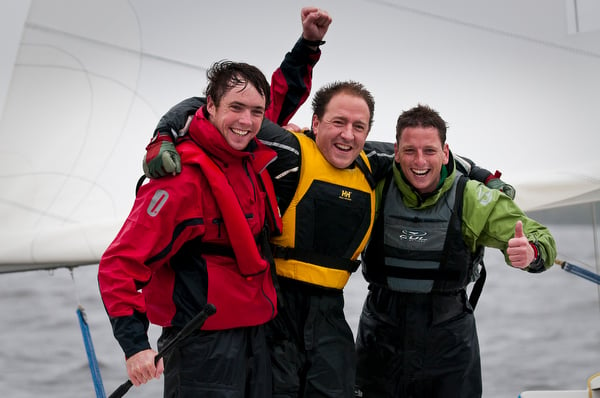
George Kenefick, Mel Collins and John Downey celebrate their win on Lough Derg. Photo: Brendan Fogarty
Back in home waters, next up was the Waterways Ireland ISA National Championship on Lough Derg in the ISA's SailFleet flotilla of J/80s at the beginning of October. For this series Kenefick recruited Crosshaven clubmates John Downey and Mel Collins as crew. The opposition included former champion Mark Mansfield, who had returned to competitive sailing by winning the 1720 Europeans in Baltimore against a fleet including Anthony and Nicholas O'Leary, both former Irish Open Champions.
It went right down to the wire, with Mansfield and O'Leary emerging well ahead on 12–points apiece. On the countback, Kenefick was the new champion. Almost immediately, he was back in the thick of logistics and personnel organization in taking the Cork Institute of Technology sailing team to France for the Student Worlds, CIT representing Ireland as winners of our national series.
With sixteen college teams from all over the world, even in resources-rich French sailing the organizers were stretched in finding an evenly-matched fleet of sixteen Archambault keelboats. There were top class new boats, but some not so new boats, and a trio of boats well past their sell-by date. It was all in the luck of the draw, and the Irish and much-fancied Portuguese found themselves drawing the shortest straw.
In a demanding series, the Portuguese were never at the races with their tired mount, but the Irish simply refused to give up despite a boat which, with its equipment, was falling apart. There was ample opportunity to do this, as the series in the Bay of Biscay off La Trinite included some really rough stuff. In fact, the Irish revelled in the strong breeze, but in the light airs which settled in as the week drew on, it took pure skill.
By the final races last Saturday, they'd got themselves an unassailable third position, but the two British teams – defending champions are allowed an extra place – had miscalculated the points situation. So on the final day, they team raced, one of their boats sailing the Irish crew down the fleet in the best Ben Ainslie style. It was the first time Ireland had finished outside the top six, but they still had the bronze, the Brits took silver, and the French were well ahead to win overall.
More from WM Nixon in the Irish Independent here




























